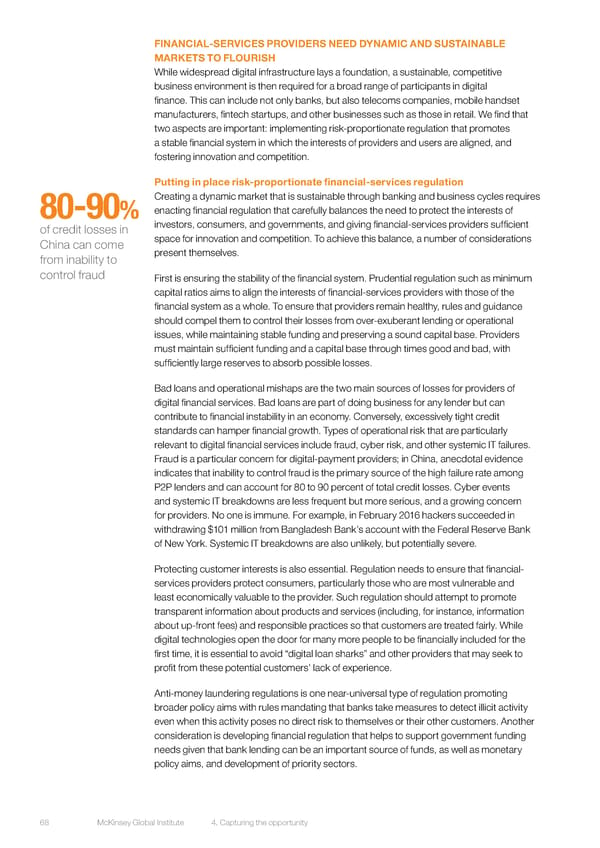FINANCIAL-SERVICES PROVIDERS NEED DYNAMIC AND SUSTAINABLE MARKETS TO FLOURISH While widespread digital infrastructure lays a foundation, a sustainable, competitive business environment is then required for a broad range of participants in digital finance. This can include not only banks, but also telecoms companies, mobile handset manufacturers, fintech startups, and other businesses such as those in retail. We find that two aspects are important: implementing risk-proportionate regulation that promotes a stable financial system in which the interests of providers and users are aligned, and fostering innovation and competition. Putting in place risk-proportionate financial-services regulation Creating a dynamic market that is sustainable through banking and business cycles requires 80-90% enacting financial regulation that carefully balances the need to protect the interests of of credit losses in investors, consumers, and governments, and giving financial-services providers sufficient China can come space for innovation and competition. To achieve this balance, a number of considerations from inability to present themselves. control fraud First is ensuring the stability of the financial system. Prudential regulation such as minimum capital ratios aims to align the interests of financial-services providers with those of the financial system as a whole. To ensure that providers remain healthy, rules and guidance should compel them to control their losses from over-exuberant lending or operational issues, while maintaining stable funding and preserving a sound capital base. Providers must maintain sufficient funding and a capital base through times good and bad, with sufficiently large reserves to absorb possible losses. Bad loans and operational mishaps are the two main sources of losses for providers of digital financial services. Bad loans are part of doing business for any lender but can contribute to financial instability in an economy. Conversely, excessively tight credit standards can hamper financial growth. Types of operational risk that are particularly relevant to digital financial services include fraud, cyber risk, and other systemic IT failures. Fraud is a particular concern for digital-payment providers; in China, anecdotal evidence indicates that inability to control fraud is the primary source of the high failure rate among P2P lenders and can account for 80 to 90 percent of total credit losses. Cyber events and systemic IT breakdowns are less frequent but more serious, and a growing concern for providers. No one is immune. For example, in February 2016 hackers succeeded in withdrawing $101 million from Bangladesh Bank’s account with the Federal Reserve Bank of New York. Systemic IT breakdowns are also unlikely, but potentially severe. Protecting customer interests is also essential. Regulation needs to ensure that financial- services providers protect consumers, particularly those who are most vulnerable and least economically valuable to the provider. Such regulation should attempt to promote transparent information about products and services (including, for instance, information about up-front fees) and responsible practices so that customers are treated fairly. While digital technologies open the door for many more people to be financially included for the first time, it is essential to avoid “digital loan sharks” and other providers that may seek to profit from these potential customers’ lack of experience. Anti-money laundering regulations is one near-universal type of regulation promoting broader policy aims with rules mandating that banks take measures to detect illicit activity even when this activity poses no direct risk to themselves or their other customers. Another consideration is developing financial regulation that helps to support government funding needs given that bank lending can be an important source of funds, as well as monetary policy aims, and development of priority sectors. 68 McKinsey Global Institute 4. Capturing the opportunity
 DIGITAL FINANCE FOR ALL Page 82 Page 84
DIGITAL FINANCE FOR ALL Page 82 Page 84